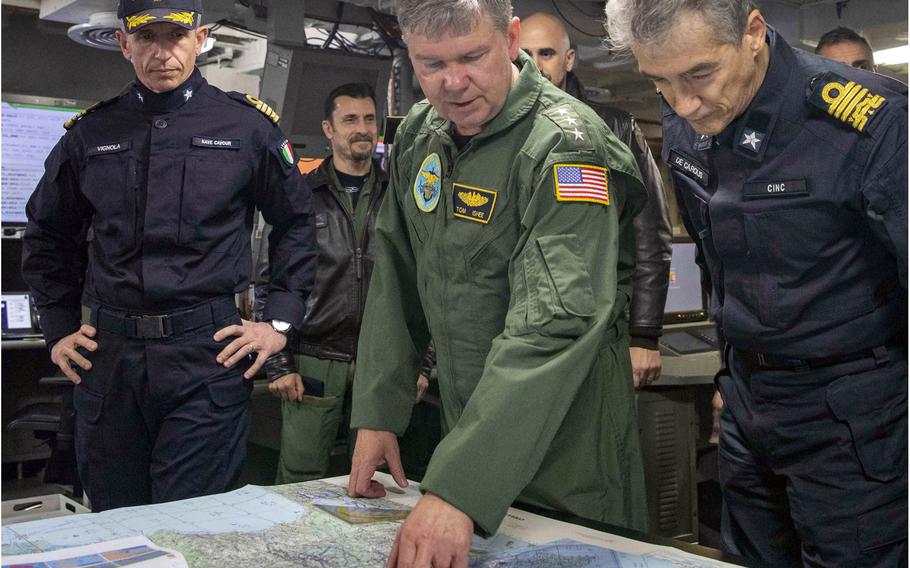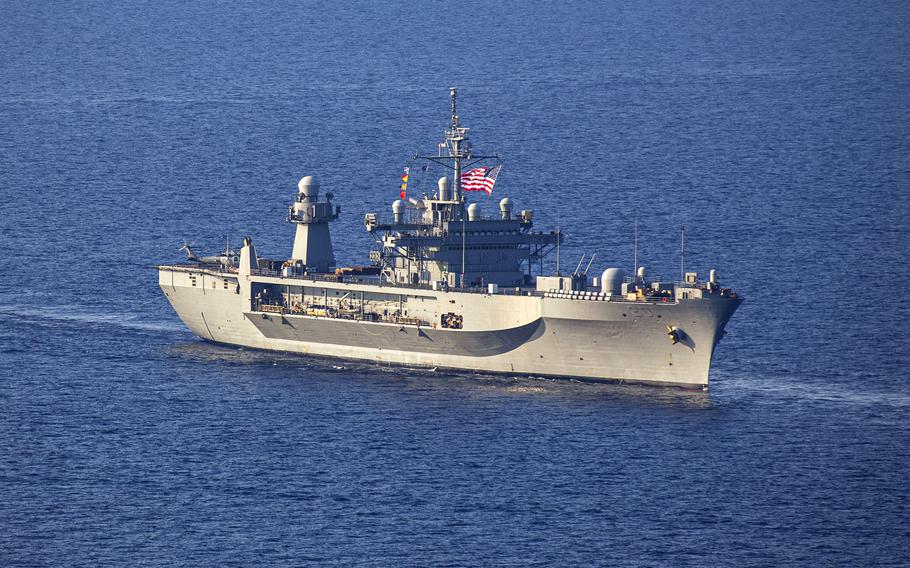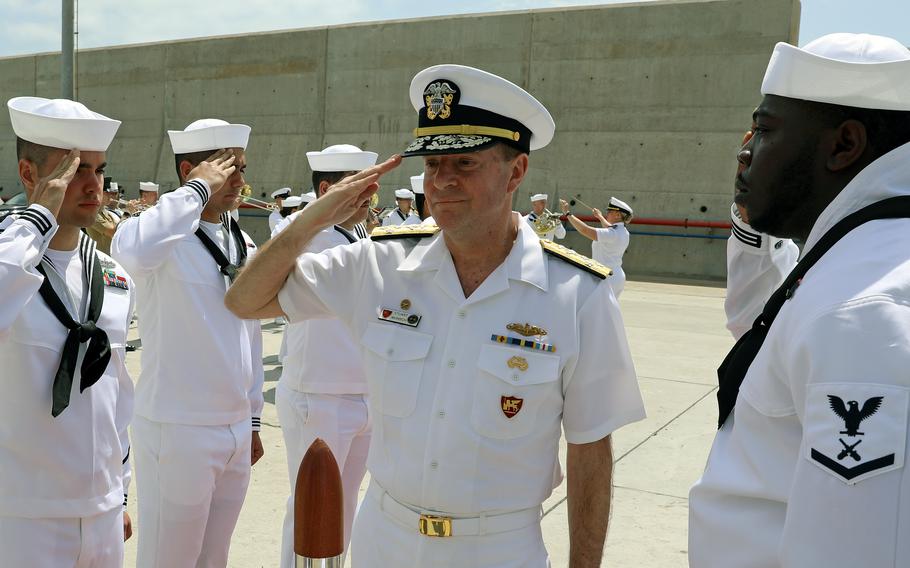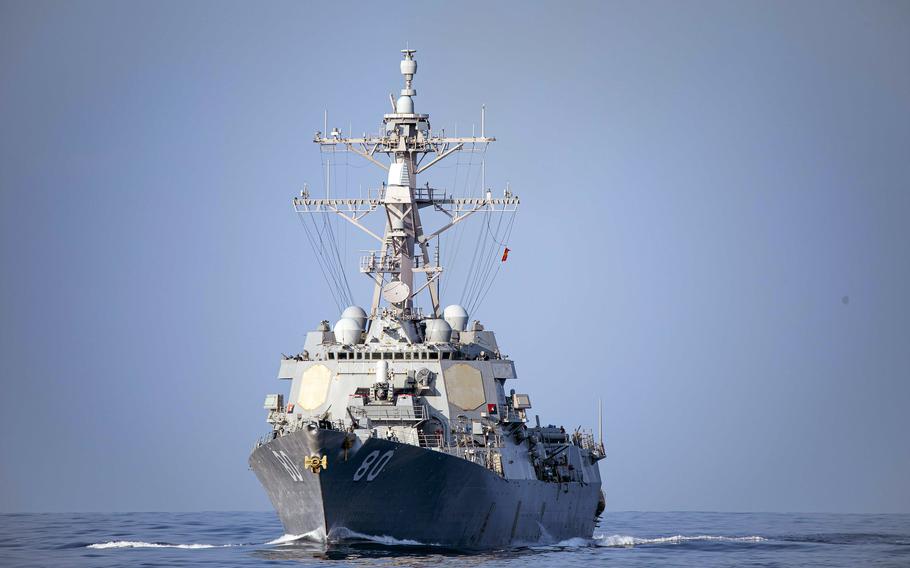
Vice Adm. Thomas Ishee, center, U.S. 6th Fleet commander, reviews a chart aboard the Italian navy aircraft carrier ITS Cavour in the Adriatic Sea on Feb. 24, 2023. (Mariano Lopez/U.S. Navy)
NAPLES, Italy — U.S. Naval Forces Europe-Africa and 6th Fleet are separating after 19 years as a single command, a move that comes as the service adapts to growing demands that include missile defense in the Baltics and carrier operations in the eastern Mediterranean Sea.
The change creates two distinct staffs and realigns each command’s organizational chart with the service’s traditional structure, Capt. Clayton Doss, a spokesman for NAVEUR-AF and 6th Fleet, said Tuesday in a statement following a Stars and Stripes query.
The decision was made to “better posture for day-to-day operations and future crises,” said Doss, who noted both staffs would continue to work together as changes are made.
It wasn’t immediately clear how far NAVEUR-AF and 6th Fleet were in the separation process, which streamlines the chain of command and clarifies focus areas for working groups and departments.
The statement did not discuss how commanding or supervisory openings created by the split would be filled.

USS Mount Whitney, the U.S. 6th Fleet flagship, sails the Mediterranean Sea on Aug. 14, 2023. The U.S. 6th Fleet and U.S. Naval Forces Europe and Africa commands are being separated by the Navy, officials said this week. (Jacob Mattingly/U.S. Navy)
But some of those changes, underway since late last year, already are visible at Naval Support Activity Naples, where the commands are headquartered. Signs at the base were altered last month to reflect separate positions for some assignments previously held by a single commanding officer.
The war in Ukraine, Russian threats in the Baltic Sea and the effects of the Israel-Hamas war in the eastern Mediterranean have brought greater focus on the European theater than at any time since the Cold War.
More U.S. ships, aircraft and tens of thousands of additional personnel have arrived in Europe during the past two years. The commands also partner with African nations to combat extremist militants and protect sea lanes.
The Navy has kept a nearly continuous aircraft carrier strike group or amphibious assault group presence in the NAVEUR-AF/6th Fleet area of responsibility for the last two years.
The addition of Finland to NATO and the pending accession of Sweden also have increased naval operations in the north.
Meanwhile, there are now four Navy destroyers homeported at Naval Station Rota in Spain. A fifth destroyer, USS Oscar Austin, will join them in the late summer.

Adm. Stuart Munsch, commander of U.S. Naval Forces Europe and Africa, boards the destroyer USS Bulkeley for a ship tour in Santa Maria, Cape Verde, March 21, 2023. U.S. Naval Forces Europe and Africa and U.S. 6th Fleet are separating staffs after 19 years of being a joint command. (Zac Shea/U.S. Navy)
When the commands merged in 2005, the service was focused on efficiency as it conducted and supported Middle East operations, said Bryan Clark, director of the Hudson Institute’s Center for Defense Concepts and Technology.
“Now, there is an increased demand on 6th Fleet as an operational command that it didn’t used to have,” said Clark, noting that 20 years ago there wasn’t a continuous presence of naval forces in the fleet’s area of responsibility.
NAVEUR-AF is engaged in U.S. European Command’s support of NATO, which includes Navy missile defense sites in Poland and Romania.
Meanwhile, missions to the south are expanding. The expeditionary sea base USS Hershel “Woody” Williams, homeported at Souda Bay on the island of Crete in Greece, operates extensively in Africa.
“Sixth Fleet is busy at sea. NAVEUR is busy ashore,” Clark said. “The Navy is well-served separating these two out again to reflect the reality that the European theater has suddenly become much more active than it was.”

The destroyer USS Roosevelt, which is homeported in Rota, Spain, in the 6th Fleet area of operations, sails the Mediterranean Sea, Oct. 12, 2023. U.S. Naval Forces Europe and Africa and 6th Fleet are separating commands, in a move Navy officials say will better position the service for daily operations and future crises. (Malachi Lakey/U.S. Navy)